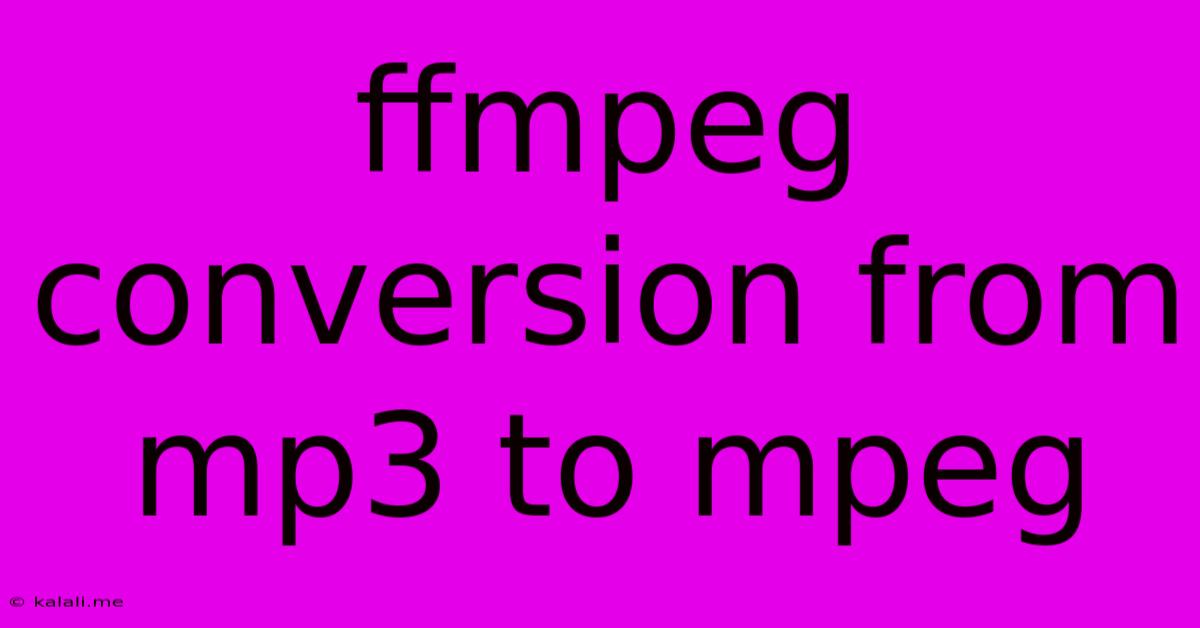Ffmpeg Conversion From Mp3 To Mpeg
Kalali
Jun 03, 2025 · 3 min read

Table of Contents
Converting MP3 to MPEG with FFmpeg: A Comprehensive Guide
FFmpeg is a powerful command-line tool capable of handling a vast array of multimedia tasks, including audio conversion. This guide will walk you through the process of converting MP3 files to MPEG audio files using FFmpeg, covering different MPEG versions and offering tips for optimal results. This includes various bitrates and channels to suit your needs.
What is MPEG? MPEG (Moving Picture Experts Group) is a family of standards for compressing audio and video data. While often associated with video, MPEG also encompasses several audio codecs, including MPEG Layer 1, Layer 2, and Layer 3 (MP3 itself). When converting from MP3, you're usually aiming for MPEG Layer 1 or Layer 2, older formats offering compatibility with legacy devices, or MPEG Layer 3, which is MP3. We'll clarify this further in the examples.
Understanding the Basics: MP3 vs. MPEG Audio
Before diving into the conversion process, it's important to understand the relationship between MP3 and MPEG audio. MP3 is actually a type of MPEG audio, specifically MPEG Layer 3. Therefore, converting from MP3 to MPEG might seem redundant. However, it allows you to target specific MPEG versions (Layer 1 or 2) for compatibility reasons or to adjust the encoding parameters for different file sizes and qualities.
Converting MP3 to MPEG using FFmpeg: A Step-by-Step Guide
The core of the conversion process lies in the FFmpeg command. Here's the general syntax:
ffmpeg -i input.mp3 -acodec libmp3lame -ab output.mp3
Let's break this down:
ffmpeg: This invokes the FFmpeg command-line tool.-i input.mp3: This specifies the input MP3 file. Replaceinput.mp3with your actual file name.-acodec libmp3lame: This sets the audio codec to use.libmp3lameis a widely used and efficient MP3 encoder. If you are targeting MPEG-1 Layer II, you'd replace this with-acodec libmp3lameand adjust your bitrate accordingly to get good results.-ab <bitrate>: This sets the audio bitrate. The bitrate determines the file size and quality; higher bitrates result in larger files with better quality. Common values include:- 128 kbps: A good balance between file size and quality.
- 192 kbps: Higher quality, larger file size.
- 256 kbps: High quality, significantly larger file size. Generally, values above this are not necessary unless you have very specific requirements.
output.mp3: This specifies the name of the output MP3 file.
Example 1: Converting to a standard 128 kbps MP3
ffmpeg -i input.mp3 -acodec libmp3lame -ab 128k output.mp3
This command converts input.mp3 to output.mp3 with a bitrate of 128 kbps using the MP3 codec.
Example 2: (Hypothetical) Converting to MPEG-1 Layer II at 192kbps (requires additional parameters)
While not directly an MPEG-1 layer II conversion from MP3 using the 'libmp3lame' codec, this example illustrates the adjustment of parameters to create an output file at a higher bitrate. This would require a different encoder, though not typically a direct conversion. Many tools can handle conversion from mp3 to mp2, but FFmpeg would require a more complex command involving an intermediate step or employing a different codec.
Troubleshooting and Advanced Options
- Error Messages: Pay close attention to any error messages FFmpeg provides. These often pinpoint issues with file paths, codecs, or other settings.
- Advanced Options: FFmpeg offers many more options for fine-tuning the conversion process. Consult the FFmpeg documentation for a complete list. For instance, you could specify the sample rate (
-ar) or the number of channels (-ac).
Conclusion
FFmpeg provides a versatile and powerful method for converting MP3 files to different MPEG audio formats. By understanding the basic command structure and adjusting parameters like the bitrate, you can achieve high-quality conversions tailored to your specific needs. Remember to always refer to the official FFmpeg documentation for the most up-to-date information and advanced options. Experimentation is key to mastering FFmpeg's capabilities!
Latest Posts
Latest Posts
-
How To Get Rid Of Frogs In Your Pool
Jun 04, 2025
-
Toilet Bowl Fills But Wont Flush
Jun 04, 2025
-
Kitchen Sink Not Draining But Not Clogged
Jun 04, 2025
-
How To Save All Texture Paintings Blender
Jun 04, 2025
-
Aircon Thermostat 1 To 10 Meaning
Jun 04, 2025
Related Post
Thank you for visiting our website which covers about Ffmpeg Conversion From Mp3 To Mpeg . We hope the information provided has been useful to you. Feel free to contact us if you have any questions or need further assistance. See you next time and don't miss to bookmark.